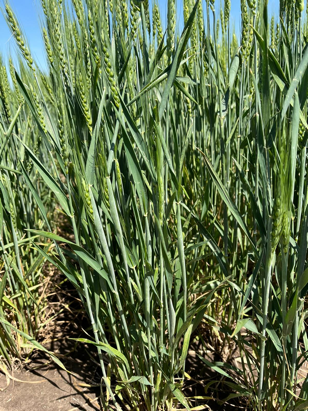Rains during the past two weeks have resulted in a flush of late, green tillers in the wheat over much of Kansas (Fig. 1). This can create a problem, especially for wheat that is approaching harvest maturity. A question that usually arises when this happens is: Should I wait to start harvesting until most of the green heads have matured, or just start harvesting anyway?

Figure 1. Wheat plants showing later-emerged tillers during the 2022 growing season. Notice the shorter and later heads in the middle to lower portions of the plants. Photo by Luiz Otavio Pradella, K-State Agronomy grad student, near Hays, Kansas.
This question is more relevant this year in south central Kansas, where the wheat is most advanced. In these cases, producers should not delay harvest because of the green tillers. These tillers probably won’t amount to more than 5% or so of the total amount of heads in the field, and won’t add much to the final yield anyway. So producers should start harvesting as soon as the bulk of the field is ready. With varieties that tend to shatter easily, producers should start harvesting as soon as the field reaches 15% moisture.
In other regions of Kansas, where the wheat is less developed, the green tillers might add more to the crop’s yield potential. Still, unless the green tillers make up more than half the heads in the fields, it’s probably best to just start harvesting when the majority of heads are ready to go. Waiting for the green heads to ripen might lead to shattering of the more mature heads.
In north central and northwest Kansas, there is plenty of time to wait and see how the new green shoots develop. In these regions, the new tillers could potentially add significantly to the yield potential, especially in northwest where the yield potential is lower than in north central. If the weather continues to be favorable and the new tillers have time to mature, then producers in northern Kansas may want to wait until the new tillers have ripened before harvesting.
Producers should be aware that the grain in the green heads may cause some storage problems. It’s never easy to manage a late flush of green shoots in wheat. There’s no clear-cut answer, nor is there one best management strategy to fit all situations, unfortunately.
Romulo Lollato, Extension Wheat and Forage Specialist
Tags: wheat wheat harvest wheat tillers